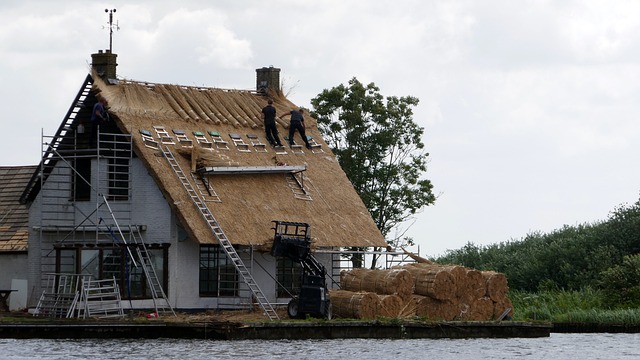Waterproofing membranes, made from synthetic materials like rubber, PVC, or modified bitumen, are crucial tools for roofers. They provide superior water resistance, sealing joints and laps to prevent leaks and protect roofs from environmental damage. Installation during new or replacement roofs ensures long-term protection against moisture, mold growth, and structural weaknesses, enhancing roofing durability and homeowner peace of mind.
As a roofer, protecting structures from water damage is paramount. Waterproofing membranes offer an effective solution for leak prevention, providing an extra layer of defense against moisture intrusion. This article delves into the world of waterproofing membranes, offering insights from a roofer’s perspective. We explore when and how to apply these membranes, highlighting their numerous benefits for structural integrity and longevity. Discover why roofing professionals increasingly rely on this game-changing technology for superior leak protection.
- Understanding Waterproofing Membranes: A Roofer's Perspective
- When and How to Apply Waterproofing Membranes
- Benefits of Using Waterproofing Membranes for Leak Prevention
Understanding Waterproofing Membranes: A Roofer's Perspective

Waterproofing membranes are a crucial component in a roofer’s arsenal for leak prevention. These specialized materials are designed to create a protective barrier between the roof surface and potential water intrusion points. From a roofer’s perspective, understanding the function and application of these membranes is key to ensuring long-lasting roof integrity.
When installing or repairing a roof, a roofer may opt to use waterproofing membranes as an additional layer of defense against leaks. These membranes are typically made from synthetic materials like rubber, PVC, or modified bitumen, offering superior water resistance compared to traditional methods. By incorporating these membranes into the roofing system, roofers can effectively seal joints, laps, and other vulnerable areas, significantly reducing the risk of water seepage and associated damage.
When and How to Apply Waterproofing Membranes

Waterproofing membranes are an essential tool for any roofer looking to prevent leaks and extend the lifespan of a roof. The best time to apply these membranes is during new roof installations or when replacing old, damaged shingles. This ensures a fresh surface on which to bond the membrane effectively. Before application, ensure the roof deck is clean, dry, and free from debris; this creates a solid base for maximum adhesion.
The process involves starting at the lowest point of the roof and working upwards in linear rows, overlapping each section slightly to create a continuous barrier against water intrusion. It’s crucial to follow the manufacturer’s instructions regarding adhesive or sealant usage and curing times. Proper application requires skill and precision, making it ideal for professional roofers who can ensure the membrane is securely fastened, filling all gaps and joints.
Benefits of Using Waterproofing Membranes for Leak Prevention

Waterproofing membranes offer numerous advantages for roopers aiming to prevent leaks and ensure structure integrity. Firstly, they create a protective barrier against moisture intrusion, blocking even the tiniest gaps or cracks that could allow water seepage. This is especially crucial in regions with harsh climates where freezing temperatures and heavy rainfall can lead to severe damage if left unaddressed.
Moreover, these membranes enhance the overall durability of roofing systems by shielding them from the constant exposure to UV rays, extreme temperatures, and other environmental factors. By installing waterproofing membranes, roofers can significantly reduce the risk of costly repairs associated with water damage, such as mold growth, structural weakening, or complete roof replacement. This long-term investment not only saves money but also ensures a more comfortable and secure living environment for homeowners.
Waterproofing membranes are an invaluable tool in a roofer’s arsenal, offering effective leak prevention and extended roof lifespan. By understanding their application and benefits, professionals can enhance their work, ensuring buildings remain dry and secure. For roofers, integrating waterproofing membranes into their practices is a smart move, providing peace of mind and superior protection against the elements.
